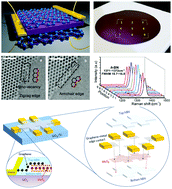当前位置:
X-MOL 学术
›
J. Mater. Chem. C
›
论文详情
Our official English website, www.x-mol.net, welcomes your
feedback! (Note: you will need to create a separate account there.)
Two dimensional hexagonal boron nitride (2D-hBN): synthesis, properties and applications
Journal of Materials Chemistry C ( IF 5.7 ) Pub Date : 2017-11-15 00:00:00 , DOI: 10.1039/c7tc04300g Kailiang Zhang 1, 2, 3, 4, 5 , Yulin Feng 1, 2, 3, 4, 5 , Fang Wang 1, 2, 3, 4, 5 , Zhengchun Yang 1, 2, 3, 4, 5 , John Wang 6, 7, 8
Journal of Materials Chemistry C ( IF 5.7 ) Pub Date : 2017-11-15 00:00:00 , DOI: 10.1039/c7tc04300g Kailiang Zhang 1, 2, 3, 4, 5 , Yulin Feng 1, 2, 3, 4, 5 , Fang Wang 1, 2, 3, 4, 5 , Zhengchun Yang 1, 2, 3, 4, 5 , John Wang 6, 7, 8
Affiliation

|
Two dimensional hexagonal boron nitride (2D-hBN), an isomorph of graphene with a very similar layered structure, is uniquely featured by its exotic opto-electrical properties together with mechanical robustness, thermal stability, and chemical inertness. It is thus extensively studied for application in field effect transistors (FETs), tunneling devices, deep UV emitters and detectors, photoelectric devices, and nanofillers. 2D-hBN is considered as one of the most promising materials that can be integrated with other 2D materials, such as graphene and transition metal dichalcogenides (TMDCs), for the next generation microelectronic and other technologies. Although it is by itself an insulator, it can well be tuned by several strategies in terms of properties and functionalities, such as by doping, substitution, functionalization and hybridization, making 2D-hBN a truly versatile type of functional materials for a wide range of applications. In this review, the distinct structural characteristics of 2D-hBN, doping- and defect-induced variations in energy bands and structures, and resultant properties, are presented. There are a wide variety of processing routes that have been developed for 2D-hBN, including also those for doping, substitution, functionalization and combination with other materials to form heterostructures or h-BNC hybrid nanosheets, which are systematically elaborated for novel functions. The comprehensive overview provides the types of the state-of-the-art 2D-hBN made by new synthesis strategies, where the mainstream approaches include exfoliation, chemical vapor deposition, and gas phase epitaxy, together with several other new methods that have been successfully developed in the past few years. On the basis of the extraordinary electrical and functional properties and thermal–mechanical stability, the applications of hBN-based nanosheets as substrates and dielectrics, passivation layers, and nanofillers in nanodevices and nanocomposites are discussed, together with the peculiar optical and wetting characteristics.
中文翻译:

二维六方氮化硼(2D-hBN):合成,性质和应用
二维六方氮化硼(2D-hBN)是具有非常相似的层状结构的石墨烯的同构物,其独特的光电特性以及机械强度,热稳定性和化学惰性是其独特的特征。因此,已经对其进行了广泛的研究,以用于场效应晶体管(FET),隧道器件,深紫外线发射器和检测器,光电器件和纳米填料中。2D-hBN被认为是可以与其他2D材料集成的最有前途的材料之一,例如石墨烯和过渡金属二卤化金属(TMDC),用于下一代微电子和其他技术。尽管它本身就是绝缘体,但可以通过几种策略在特性和功能方面进行很好的调整,例如通过掺杂,取代,功能化和杂交,使2D-hBN成为一种真正用途广泛的功能材料,适用于广泛的应用。在这篇综述中,介绍了2D-hBN的独特结构特征,掺杂和缺陷引起的能带和结构变化以及所产生的特性。已经为2D-hBN开发了各种各样的加工路线,包括用于掺杂,取代,功能化以及与其他材料结合以形成异质结构或h-BNC杂化纳米片的加工路线,这些路线已系统地阐述了新功能。全面的概述提供了通过新的合成策略制成的最新2D-hBN的类型,其中主流方法包括剥离,化学气相沉积和气相外延,以及在过去几年中成功开发的其他几种新方法。基于非凡的电气和功能特性以及热机械稳定性,讨论了基于hBN的纳米片作为基底和电介质,钝化层和纳米填料在纳米器件和纳米复合材料中的应用,以及特殊的光学和润湿特性。
更新日期:2017-11-15
中文翻译:

二维六方氮化硼(2D-hBN):合成,性质和应用
二维六方氮化硼(2D-hBN)是具有非常相似的层状结构的石墨烯的同构物,其独特的光电特性以及机械强度,热稳定性和化学惰性是其独特的特征。因此,已经对其进行了广泛的研究,以用于场效应晶体管(FET),隧道器件,深紫外线发射器和检测器,光电器件和纳米填料中。2D-hBN被认为是可以与其他2D材料集成的最有前途的材料之一,例如石墨烯和过渡金属二卤化金属(TMDC),用于下一代微电子和其他技术。尽管它本身就是绝缘体,但可以通过几种策略在特性和功能方面进行很好的调整,例如通过掺杂,取代,功能化和杂交,使2D-hBN成为一种真正用途广泛的功能材料,适用于广泛的应用。在这篇综述中,介绍了2D-hBN的独特结构特征,掺杂和缺陷引起的能带和结构变化以及所产生的特性。已经为2D-hBN开发了各种各样的加工路线,包括用于掺杂,取代,功能化以及与其他材料结合以形成异质结构或h-BNC杂化纳米片的加工路线,这些路线已系统地阐述了新功能。全面的概述提供了通过新的合成策略制成的最新2D-hBN的类型,其中主流方法包括剥离,化学气相沉积和气相外延,以及在过去几年中成功开发的其他几种新方法。基于非凡的电气和功能特性以及热机械稳定性,讨论了基于hBN的纳米片作为基底和电介质,钝化层和纳米填料在纳米器件和纳米复合材料中的应用,以及特殊的光学和润湿特性。











































 京公网安备 11010802027423号
京公网安备 11010802027423号